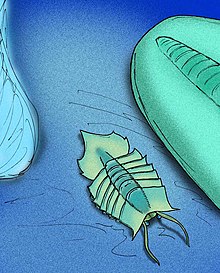
Agnostida are an order of extinct arthropods which have classically been seen as a group of highly modified trilobites, though some recent research has doubted this placement. Regardless, they appear to be close relatives as part of the Artiopoda. They are present in the Lower Cambrian fossil record along with trilobites from the Redlichiida, Corynexochida, and Ptychopariida orders, and were highly diverse throughout the Cambrian. Agnostidan diversity severely declined during the Cambrian-Ordovician transition, and the last agnostidans went extinct in the Late Ordovician.

Hallucigenia is a genus of lobopodian, known from Cambrian aged fossils in Burgess Shale-type deposits in Canada and China, and from isolated spines around the world. The generic name reflects the type species' unusual appearance and eccentric history of study; when it was erected as a genus, H. sparsa was reconstructed as an enigmatic animal upside down and back to front. Lobopodians are a grade of Paleozoic panarthropods from which the velvet worms, water bears, and arthropods arose.

Opabinia regalis is an extinct, stem group arthropod found in the Middle Cambrian Burgess Shale Lagerstätte of British Columbia. Opabinia was a soft-bodied animal, measuring up to 7 cm in body length, and its segmented trunk had flaps along the sides and a fan-shaped tail. The head shows unusual features: five eyes, a mouth under the head and facing backwards, and a clawed proboscis that probably passed food to the mouth. Opabinia probably lived on the seafloor, using the proboscis to seek out small, soft food. Fewer than twenty good specimens have been described; 3 specimens of Opabinia are known from the Greater Phyllopod bed, where they constitute less than 0.1% of the community.

Marrella is an extinct genus of marrellomorph arthropod known from the Middle Cambrian of North America and Asia. It is the most common animal represented in the Burgess Shale of British Columbia, Canada, with tens of thousands of specimens collected. Much rarer remains are also known from deposits in China.

Sidneyia is an extinct arthropod known from fossils found from the Early to the Mid Cambrian of China and the Mid Cambrian Burgess Shale of British Columbia, Canada.

Yohoia is an extinct genus of megacheiran arthropod from the Cambrian period that has been found as fossils in the Burgess Shale formation of British Columbia, Canada. The type species, Yohoia tenuis, was described in 1912 by Walcott, who considered it an anostracan crustacean. 711 specimens of Yohoia are known from the Greater Phyllopod bed, where they comprise 1.35% of the community. In 2015, Conway Morris et al. reported another species, Y. utahana, from the Marjum Formation, Utah.

Anomalocaris is an extinct genus of radiodont, an order of early-diverging stem-group arthropods.

Canadaspis is an extinct genus of bivalved Cambrian arthropod, known from North America and China. They are thought to have been benthic feeders that moved mainly by walking and possibly used its biramous appendages to stir mud in search of food. They have been placed within the Hymenocarina, which includes other bivalved Cambrian arthropods.
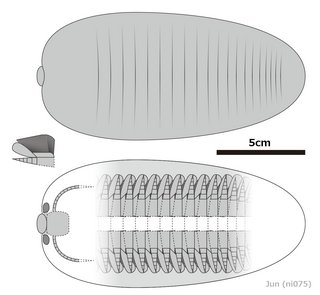
Saperion is an extinct genus of trilobite-like arthropod. It lived during the late Atdabanian stage, which lasted from 521 to 514 million years ago during the early part of the Cambrian Period. It was found in the Maotianshan Shales of Yunnan, China. Similar to the closely-related Skioldia and Tegopelte, the head shield and trunk tergites were fused into a single plate. There are about 19 furrows indicating the original trunk segments. a small anterior sclerite articulated to the front of its head. A pair of antennae and lateral eyes located ventrally behind the anterior sclerite, lateral to the hypostome. Saperion reached 151 mm in length and had nearly 25 pairs of biramous limbs for walking.

Odaraia is a genus of bivalved arthropod from the Middle Cambrian. Its fossils, which reach 15 centimetres (5.9 in) in length, have been found in the Burgess Shale in British Columbia, Canada.
A number of assemblages bear fossil assemblages similar in character to that of the Burgess Shale. While many are also preserved in a similar fashion to the Burgess Shale, the term "Burgess Shale-type fauna" covers assemblages based on taxonomic criteria only.
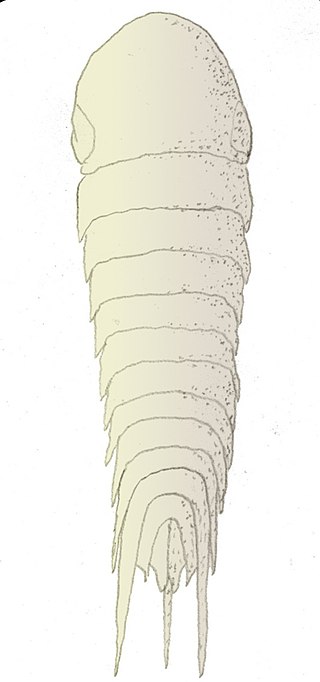
Acanthomeridion is an extinct arthropod found in the Chengjiang fauna deposits of China. In 1997, it was placed in its own, monotypic family, Acanthomeridiidae. It is known from eight specimens, all found in China.
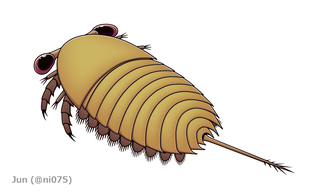
Sarotrocercus is a small Cambrian arthropod known from Burgess shale, reaching a centimetre or two in length (0.39–0.79 in). Sarotrocercus is only known from 7 specimens. It may lie in the arthropod crown group, and a recent study has revised some points of its original description.

Alalcomenaeus is one of the most widespread and longest-surviving arthropod genera of the Early and Middle Cambrian. Known from over 300 specimens in the Burgess Shale and the Chengjiang biota. It is a member of the family Leanchoiliidae in the group Megacheira.

Megacheira is an extinct class of predatory arthropods defined by their possession of spined "great appendages". Their taxonomic position is controversial, with studies either considering them stem-group euarthropods, or stem-group chelicerates. The homology of the great appendages to the cephalic appendages of other arthropods is also controversial. Uncontested members of the group were present in marine environments worldwide from the lower to middle Cambrian.

Haikoucaris is a genus of megacheiran arthropod that contains the single species Haikoucaris ercaiensis. It was discovered in the Cambrian Chengjiang biota of China.

Kiisortoqia soperi is an extinct species of arthropod from the Early Cambrian Sirius Passet Lagerstätte in Greenland. While it had a superficially trilobite-like bodyform, it also possessed large frontal appendages similar to those of radiodonts.

Skeemella clavula is an elongate animal from what is now the Middle Cambrian Wheeler Shale and Marjum lagerstätte of Utah. It has been classified with the vetulicolians.

Tegopelte gigas is a species of large soft-bodied arthropod known from two specimens found in the Middle Cambrian Burgess Shale of British Columbia, Canada.
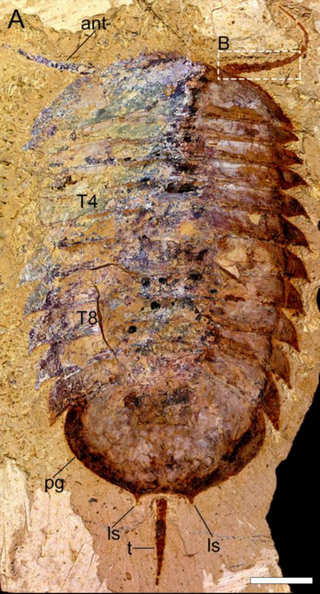
Retifacies abnormalis is an extinct arthropod that lived in the lower Cambrian. Its fossil remains have been found in the Maotianshan Shales of Yunnan, China. It is a member of the Artiopoda, and closely related to Pygmaclypeatus.
